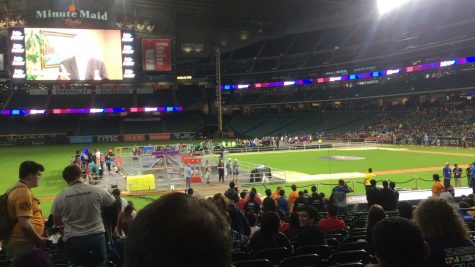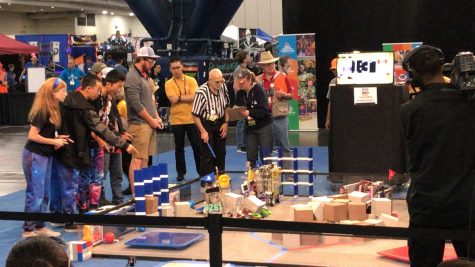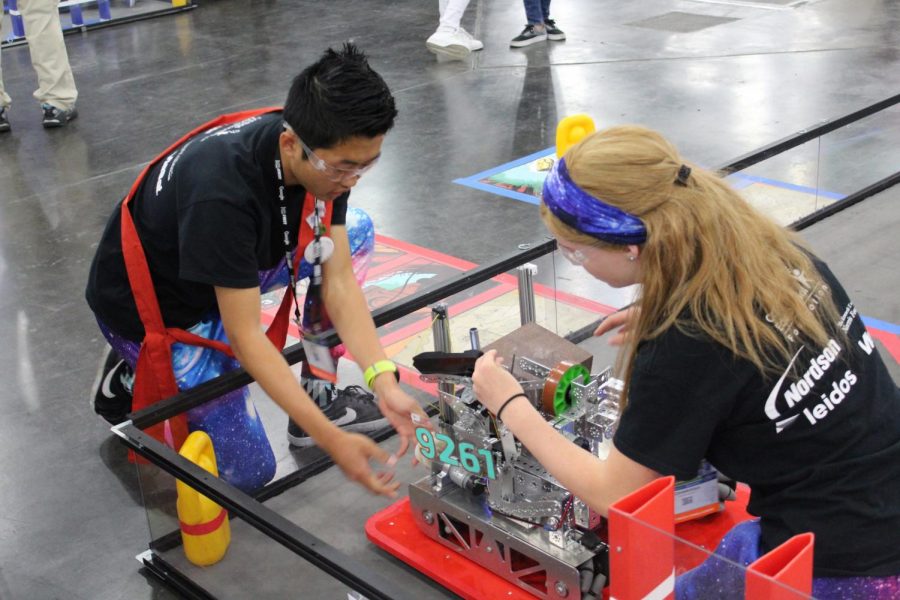Houston, We Have Robotics!
Robotics students traveled to Houston, Texas to participate in a world competition. After their four-day journey, the team ended up coming in 25th place out of 64 teams.
May 11, 2018
The robotics team placed in the top one-third of the world at the FIRST Championship last week, ending in 25th place out of the 64 teams in their league. These students traveled to Houston, Texas to participate in the exciting four-day competition against teams from all around the world.
Students Joey Babcock, Ana Diaz, Danylo Drohobytsky, Bella Eiler, Charissa Feldmann, Eric Guo, Emily Howard, Warren Howard, Riley Hull, Marco Lam, Andrew Liang, Cole Savage, Bryce Sconyers, Chris Suzuki, Matthew Suzuki and Ananya Thyagarajan attended this event from April 18 to April 21. There are two world competitions hosted by the international non-profit organization known as FIRST, which stands for “For Inspiration and Recognition of Science and Technology.” The competition encourages the growth of skills relevant to real-world engineering in participants as they strive to come out victorious in games against other competitors. These games test teams’ abilities to build, program, and work together. Robotics Club president Danylo Drohobytsky explained the elation felt upon seeing the various designs each team comes up with.
“It’s always amazing to see all these different designs,” Drohobytsky said. “You’d think that after almost a year of building, everyone would have… one amazing design, but actually the winners at the competition had two or three different designs on their alliance side.”
Many may think that a world competition would be buzzing with rivalries, but this simply was not the case in Houston. According to junior Bella Eiler, the competition brought people together rather than driving them apart.
“I really got a sense [that] everyone was rooting for everyone else in the competition, it’s not like a complete one-on-one against people, it’s more of like a friendly competition,” Eiler explained.
Senior Minh Vu felt the same way about the competition as Eiler, expressing the sentiment that it was interesting just to see how different people approached the games in different ways.
“Because it [was] an international competition, [we got] to see people from a lot of different backgrounds, a lot of different countries,” Vu stated. “We [were] all doing the same thing, we [were] all building the robots to complete this game, but [we got] to see how other people have tried to accomplish the challenge.”
The diversity of the people that students met at the competition proved to be a highlight for many of the trip. With 128 teams in total at the competition from all sorts of places, there was no end to the excitement of meeting new people.
“[I loved] meeting all the teams from around the world,” Eiler said, “Specifically we talked to a bunch of teams from China, and in our hotel, we had a team from Israel which we became pretty close with.”

The final matches take place in Minute Maid Field for the competition. While our robotics team did not make it into finals they rejoiced in spending their last day watching others do what they love as well as hearing founders of FIRST give speeches.
One of Drohobytsky’s favorite memories from the trip had to do with one of the international teams they met and a game the team set up for others to enjoy.
“There [were] lots of different teams from different countries, areas, regions, cultures and… our pits, the areas where we keep our robots and present our findings and such, [were across from] a team from Mexico,” Drohobytsky remembered, “They made this kind of scavenger hunt which involved finding boxes and in the boxes there were puzzles, and if you found all the boxes and completed all the puzzles you would get some candy.”
The competition was not all fun and games; the team had to work very hard in order to prepare for the challenges their robots would face. Vu explained the process of creating their robots as well as the many hours of work that go into bringing their ideas to life.
“We brainstorm and begin with an idea… then we sketch the idea and… CAD it, which is computer-aided design, and then we finally make it come to life using real parts,” Vu explained, “Before competitions we… work a lot harder than usual. At times we would work everyday… [from] after school to 8:30 [p.m.], and we would also meet all day on weekends.”
Sophomore Cole Savage gave some insight on some of the programs the team focused on during their preparation.
“We tried to get our autonomous period programs and our driver-controlled period programs working correctly,” Savage said.
The team went through some trial and error in their decisions regarding the design of the robot used in the competition and ended up settling on a robot affectionately nicknamed “Flippy Boy.”
“We started out with one robot and it had like a conveyor belt to do the task, but the conveyor belt kept breaking so we decided to switch to more of a dump truck design, which we named Flippy Boy,” Vu shared, “Our original robot was named Pegasus and then the second one, Flippy Boy, is formally named Polaris.”
Since their robotics program, “Level-Up,” is space themed, the robots were named after star formations.
“Pegasus… is a star formation [and] Polaris… is the North Star,” Eiler explained.
It took more than just working out the designs of the robots for the team to get ready for the competition. There is a school rule that if a club is invited to attend an event, students cannot be made to pay out of pocket. This meant that the robotics team was faced with the daunting task of raising enough money for all the members to be able to go. Senior Eric Guo provided some information on the ways the club went about this task.
“[We did] a lot of fundraising, [went] to different events, [asked] companies for sponsorships or grants, that type of stuff,” Guo said.
Vu gave some further detail on the endeavor of raising money, naming some of the companies that helped the team get to the competition.
“We calculated the total cost and everything and it ended up being around $25,000 for the whole team to go, so we needed a way to raise this money,” Vu shared, “To do this we reached out to local companies like Thermo-Fisher, ViaSat, Nordson, and they all gave us money, and we also had a crowd-source funding page, like a GoFundMe, that transferred the money into CEF’s account for us.”
Once the team had the money, they had to get themselves and their equipment to the competition, which proved to be harder than it sounds.
“We had to do a bunch of packing and figure out how to fit all of our supplies into five suitcases,” Eiler laughed as she remembered the difficult task.
The world competition held in Houston includes all levels of robotics and tests these teams’ skills in various ways that make the judges’ final decisions accurate. Drohobytsky gave an in-depth description of the competition from a participant’s point of view.
 “You progress on from regional competitions here to regionals to super-regionals, and what Level-Up got a chance to do is actually go to one of the two world competitions in Houston, Texas. The world competition housed all levels of robotics from elementary, middle school to high school,” Drohobytsky explained, “This world competition actually allows the teams to have a lot of rounds [which makes] the rankings really accurate. And from there on you have the same system of, you have alliance partners, you choose partners, and you go to kind of a play-offs match.”
“You progress on from regional competitions here to regionals to super-regionals, and what Level-Up got a chance to do is actually go to one of the two world competitions in Houston, Texas. The world competition housed all levels of robotics from elementary, middle school to high school,” Drohobytsky explained, “This world competition actually allows the teams to have a lot of rounds [which makes] the rankings really accurate. And from there on you have the same system of, you have alliance partners, you choose partners, and you go to kind of a play-offs match.”
The robotics team did not even exist five years ago and now they have been to a world competition. However, according to Drohobytsky, their youngness proved to be an asset in making it into the event.
“The program that Level-Up got through into worlds competition is interesting because it allows newer teams, or less experienced teams to go to world competitions,” Drohobytsky said, “And actually as your team gets older you have a smaller chance of getting off the waitlist.”
Once the team touched down in Texas, the four days of competition passed in a blur of excitement and engineering. Vu laughed as he remembered the overall awe and shock of the first moments at the event.
“It was nice to see all the different teams, especially on the first day. It was the first time we saw all the teams from all the different countries and then that was when we were like ‘Shoot, it’s real, we’re here,’” Vu reminisced.
The competition was pretty much a whirlwind of constant matches and tournaments from the moment they got there until the final day. Guo gave some details on what the team went through day by day.
“The competition went on from Wednesday to Saturday, so the entire time, we were doing some type of competing,” Guo explained, “The first day we had judging, where we had to prepare a script and memorize that pretty much the night before and then… the second and third day we were competing and had games.”
“[On the last day], we watched the finals at Minute Maid Park, which was right next door, and then they revealed next year’s game,” Guo said.
Even though the team was consistently competing, their time there was not nerve-wracking, or at least not for Vu.
“[I wasn’t nervous]. I was like ‘Well, we’re here, time to have fun,’” Vu asserted, “If you are nervous on the day of competition it just feels like you didn’t prepare enough.”
However, sometimes things inevitably go wrong even when you have prepared everything to the tee.
“We realized about halfway through [one of our matches] that we were missing a critical part of our code and we actually lost… because of that by seven points and it would have put us over of the top,” Savage recounted.
Despite this one mishap, the team had many successes in their matches and Savage remembered them with pride.
“During the second half there was a game where we won by only like one point,” Savage shared, “There [also] was a match that we weren’t supposed to win according to the predictions that were coming out, but we won it by I think more than a hundred points.
Besides the awards given out to teams for craftsmanship and planning and such, there were also a few exclusive awards given to stand-out students chosen by the judges. Savage was a receiver of one of these awards and his teammates expressed their delight for him.
“We had one of our team members win a You Inspire Me badge, which is like one of the biggest things a solo member of the team can earn,” Eiler explained.
“Only forty of them were given out to the entire competition and one of our team members got one,” Guo added.
Savage received the award after performing excellently under pressure and informing skeptical judges on how their team did something that was not documented properly.
“I got the You Inspire Me award because I did machine-learning for part of our algorithms and we did not document it that well unfortunately so the judges did not actually think we did it,” Savage explained, “They came over to the pit area where everyone was and I explained what we did and how we did it and they were really impressed.”
Robotics is more than just a hobby for Savage, it provides practice for what he hopes to do in the future.
“I joined the robotics team because I really like building and coding the robot and just like technology in general,” Savage shared, “I definitely want to go into a STEM-related field.”
This is a common theme in robotics team members and Eiler also sees herself working in a robotics-related field in the future.
“I want to possibly be an aerospace engineer for NASA, or for any other aerospace company, so this will help me a lot with it,” Eiler stated.
Many of the team members have been with the club for all of their high school careers and will miss it as they go off to college in the fall, but they will cherish the memories they made in their time as a part of it.
“It was a lot of fun. Although it was hard with all the hours of work, I enjoyed it. Mostly because my close friends were on the team with me too,” Vu shared.
 “I will [miss robotics]l. But I’m leaving behind a great team and some great leadership,” Guo said with a smile.
“I will [miss robotics]l. But I’m leaving behind a great team and some great leadership,” Guo said with a smile.
Although Drohobytsky is only a junior, he will be graduating early and is to attend the University of California, San Diego, next year. He has been in the FIRST Robotics Program for years and as president of the club, it is clear that the program did not lose meaning through the years, but became an even more important part of his life.
“Of course I will miss the program, it has been a massive part of my life for the better part of six years and especially this year,” Drohobytsky lamented, “I’m kind of sad but also proud to leave lots of lots of freshmen and sophomores who will be taking over next year. Hopefully [I will see the club] grow and grow and keep going to worlds.”
Now that the team has gone to worlds, there are a few new things they want to introduce to the club in the years to come to help the team continue to flourish. Savage thinks that the club should encourage people to be more versatile in what they choose to do on the team as well as document more to avoid future mishaps.
“I think that next year we are probably going to try to generalize more, so people will do both hardware and software, and also probably more documentation, like we did not record very much data in our notebook,” Savage said.
This year the club had a lot more members than before, and Eiler attests that the team will continue to adjust to that.
“This year we had an influx of new people come in, so our team kind of grew exponentially from like 12 members to 17,” Eiler shared, “we had a little problem with organization and making sure everyone was doing something all the time, so maybe next year [we should work on] a more organized system.”
Drohobytsky hopes that this will continue to be a thing that the team needs to adjust to and prompts any and all people to join the club, no matter what their interests are.
Now that Sage Creek has a Worlds-Level robotics team I would encourage everyone to join,” Drohobytsky encouraged, “It’s always important to remember that you can join with absolutely no experience, you don’t even have to like robots and programming. You can make logos, you can make videos, you can do marketing on Instagram, there is so much more to it than just building robots.”
This team has come far in its five years and there is sure to be many amazing things in the years to come. Guo leaves his beloved team with the following advice for the future:
“Stay organized, trust in each other, and create a community.”






